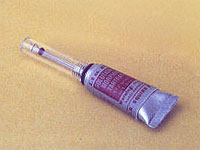Morphine Syrette

A standard part of a medic's equipment, the morphine Syrette consisted of a small tube of morphine with an attached hypodermic needle. The morphine was administered by piercing the patient's skin with the needle (after a seal was broken with a small needle) and then squeezing the tube. The Syrette itself was developed and trademarked by Squibb (currently the Bristol-Myers Squibb Company).
Although the injection of morphine straight into the bloodstream is more addicting than any other means (such as smoking or ingesting opium, from which morphine is derived), morphine has been widely used since the American Civil War as a quick means to ease the pain of injured soldiers in the field.
In an effort to prevent overdosing and possible addiction, World War II medics were instructed to attach the used Syrette to the patient's collar in order to prevent additional morphine being administered during later stages of treatment.
Fact vs. Fiction
The method of injecting the morphine shown in the film is incorrect. Instead of the quick stabbing motion seen, the Syrette should have been inserted into the skin at a shallow angle. Considering that medics carried a limited supply of morphine, it is questionable that a commanding officer would have allowed more than one shot of morphine to be given to a dying man.

